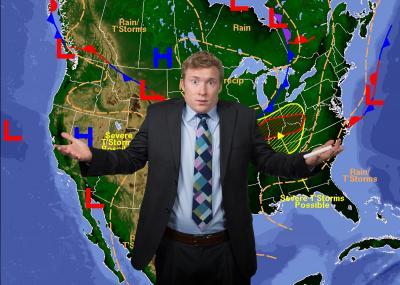It's easy to blame weather forecasting when the forecast says one thing and ends up being another, but Brigham Young University mechanical engineering professor Julie Crockett says it may not be the fault of the meteorologists.
According to Crockett, forecasters make mistakes because the models they use for predicting weather can't accurately track highly influential elements called internal waves.
Atmospheric internal waves are waves that propagate between layers of low-density and high-density air. Although hard to describe, almost everyone has seen or felt these waves. Cloud patterns made up of repeating lines are the result of internal waves, and airplane turbulence happens when internal waves run into each other and break.

BYU fluid dynamics expert and engineering professor Julie Crockett says she has figured out why the weatherman is so often wrong. Credit: Jaren Wilkey/BYU
"Internal waves are difficult to capture and quantify as they propagate, deposit energy and move energy around," Crockett said. "When forecasters don't account for them on a small scale, then the large scale picture becomes a little bit off, and sometimes being just a bit off is enough to be completely wrong about the weather."
One such example may have happened in 2011, when Utah meteorologists predicted an enormous winter storm prior to Thanksgiving. Schools across the state cancelled classes and sent people home early to avoid the storm. Though it's impossible to say for sure, internal waves may have been driving stronger circulations, breaking up the storm and causing it to never materialize.
"When internal waves deposit their energy it can force the wind faster or slow the wind down such that it can enhance large scale weather patterns or extreme kinds of events," Crockett said. "We are trying to get a better feel for where that wave energy is going."

Internal waves. The complicated x-factor that causes meteorologists to be wrong so often. Credit: Mark A. Philbrick/BYU
Internal waves also exist in oceans between layers of low-density and high-density water. These waves, often visible from space, affect the general circulation of the ocean and phenomena like the Gulf Stream and Jet Stream.
Both oceanic and atmospheric internal waves carry a significant amount of energy that can alter climates.
Crockett's latest wave research, which appears in a recent issue of the International Journal of Geophysics, details how the relationship between large-scale and small-scale internal waves influences the altitude where wave energy is ultimately deposited.
To track wave energy, Crockett and her students generate waves in a tank in her lab and study every aspect of their behavior. She and her colleagues are trying to pinpoint exactly how climate changes affect waves and how those waves then affect weather.

Credit: Mark A. Philbrick/BYU
Based on this, Crockett can then develop a better linear wave model with both 3D and 2D modeling that will allow forecasters to improve their weather forecasting.
"Understanding how waves move energy around is very important to large scale climate events," Crockett said. "Our research is very important to this problem, but it hasn't solved it completely."


